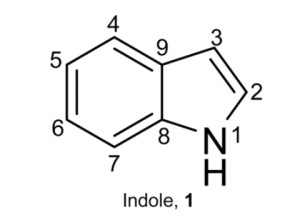 Using biochemical methods and NMR-based comparative metabolomics in conjunction with the nematode Caenorhabditis elegans, we developed a bioassay to identify secreted small molecules produced by these pathogens.
Using biochemical methods and NMR-based comparative metabolomics in conjunction with the nematode Caenorhabditis elegans, we developed a bioassay to identify secreted small molecules produced by these pathogens.
We identified indole, indole-3-carboxaldehyde (ICA), and indole-3-acetic acid (IAA), as factors that only in combination are sufficient to kill C. elegans. Importantly, although lethal to C. elegans, these molecules downregulate several bacterial processes important for pathogenesis in mammals. These include motility, biofilm formation and production of Shiga toxins. Some pathogenic E. coli strains are known to contain a Locus of Enterocyte Effacement (LEE), which encodes virulence factors that cause “attaching and effacing” (A/E) lesions in mammals, including formation of actin pedestals.
We found that these indole derivatives also downregulate production of LEE virulence factors and inhibit pedestal formation on mammalian cells. Finally, upon oral administration, ICA inhibited virulence and promoted survival in a lethal mouse infection model. In summary, the C. elegans model in conjunction with metabolomics has facilitated identification of a family of indole derivatives that broadly regulate physiology in E. coli, and virulence in pathogenic strains. These molecules may enable development of new therapeutics that interfere with bacterial small-molecule signaling.
PLOS ONE, DOI: 10.1371/journal.pone.0054456
Bettina Bommarius, Akwasi Anyanful, Yevgeniy Izrayelit, Shantanu Bhatt, Emily Cartwright, Wei Wang, Alyson I. Swimm, Guy M. Benian, Frank C. Schroeder, Daniel Kalman
http://journals.plos.org/plosone/article?id=10.1371/journal.pone.0054456
